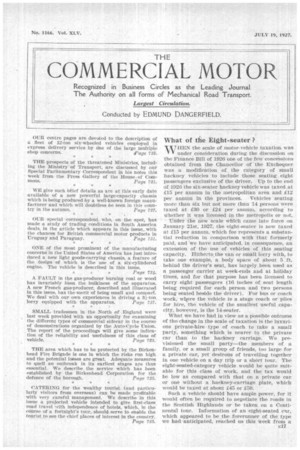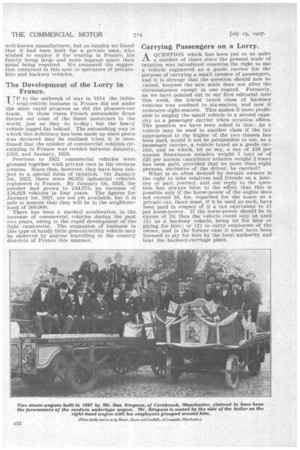What of the Eight-seater ?
Page 39

Page 40

If you've noticed an error in this article please click here to report it so we can fix it.
HEN the scale of motor-vehicle taxation. was under consideration during the discussion on the Finance Bill of 1926 one of the few concessions obtained from the Chancellor A:1f the Exchequer was a modification of the category of small hackney. itehicles to include those seating eight passengers exclusive of the driver. Up to the end of 1926 the six-seater hackney vehicle was taxed at £15 per annum in the metropolitan area and £12 per annum in the provinces. Vehicles -seating more than six but not more than 14 persons were taxed at £30 or £24 per annum, according' to whether it was licensed in the metropolis or not.
Under the new scale NAIICh came into force on January 21st, .1927, the eight-seater is now taxed at £15 per annum, which fee represents a substantial reduction in comparison with that formerly paid, and 'we have anticipated, in consequence, an extension of the use of vehicles of this seating capacity. Hitherto the van or small lorry with, to take one example, a body space of about 5 ft. behind the driver's seat, has largely been used as a passenger carrier at week-ends and at holiday times, and for that purpose has been licensed to carry eight passengers (16 inches of seat length being required for each person and two persons being seated beside the driver). For bus or coach work, witere the vehicle is a stage coach or plies for hire, the vehicle of the smallest useful capacity, however, is the 14-seater.
What we have had in view as a Possible outcome of tha change in the scale of taxation is the luxurious private-hire type of coach to take a small party, something which is nearer to the private car than to the hackney carriage. We previsioned the small party—the members of a family, or a small group of friends, too large for a private car, yet desirous of travelling together in one vehicle on a day trip or a short tour. The eight-seated-category vehicle would be quite suitable for this class of work, and the tax would be, low as compared with that on a private car or one without a hackney-carriage plate, which would be taxed at about £45 or £50.
Such a vehicle should have ample power, for it would often be required to negotiate the roads in the Scottish Highlands or be taken on a Continental tour. Information of an eight-seated car, which appeared to be the forerunner of the type we had anticipated, reached us this week from a well-known manufacturer, but on inquiry we found that it had been built for a private user, who wished to employ it for touring in France, his family being large and more luggage space than usual being required. We commend the suggestion contained in this note to operators of privatetire and hackney vehicles.
The Development of the Lorry in France.
T TP to the outbreak of war in 1914 the Indus trial-vehicle business in France did not make the same rapid progress as did the pleasure-car trade. In those times French automobile firms turned out some of the finest motorcars in the world, just as they do to-day ; but the heavy vehicle lagged far behind. The astonishing way in which this deficiency has been made up since peace was declared may be realized when it is mentioned that the number of commercial vehicles circulating in France was trebled between January, 1922, and January, 1926.
Previous to 1921 commercial vehicles were grouped together with private cars in the revenue returns. Since then, however, they have been subject to a special form of taxation. • On January 1st, 1022, there were 86,852 industrial vehicles registered in France. By January 1st, 1926, the number had grown to 244,875; an increase of 158,023 vehicles in four years. The figures for January 1st, 1927, are not yet available, but it is safe to assume that they will be in the neighbourhood of 300,000.
There has been a marked acceleration in the increase of commercial, vehicles during the past two years, owing to the rapid development of-the light camionette. The expansion of business in this type of handy little general-utility vehicle may be observed by anyone travelling in the country districts of Francethis summer.
Carrying Passengers on a Lorry.
AQUESTION which has been put to us quite a number of times since the present scale of taxation was introduced concerns the right to use a vehicle registered as a goods carrier for the purpose of carrying a small number of passengers, and it is strange that the question should now be raised, because the new scale does not alter the circumstances except in one regard. Formerly, as we have pointed out in our first editorial note this week, the lowest taxed class of hackney vehicles was confined to six-seaters, and now it embraces eight-seaters. This makes it more profitable to employ the small vehicle in a second capacity as a passenger carrier when occasion offers. The question we have been asked is this : As a vehicle may be used in another class if the tax appropriate to the higher of the two classes has been paid, would it not be permissible to use, as a passenger carrier, a vehicle taxed as a goods carrier, and on which, let us say, a tax of £16 per annum (maximum unladen weight 1 ton) or of £26 per annum (maximum unladen weight 2 tons) has been paid, provided that no more than eight persons, exclusive of the driver, be carried? What is so often desired by certain owners is the right to take relatives and friends on a journey or part journey, and our reply to the question has always been to the effect that this is possible only if the horse-power ot the engine does not exceed 16, for, regarded for the nonce as a private car, there must, if it be used as such, have been paid in respect of it a tax equivalent to £1 per horse-power. If the horse-power should be in excess of 16, then the vehicle could only be used (1) as a hackney vehicle, being let for hire or plying for hire ; or (2) to carry employees of the owner, and in the former case it must have been licensed to ply for hire by the local authority and bear the hackney-carriage plate.












































































































